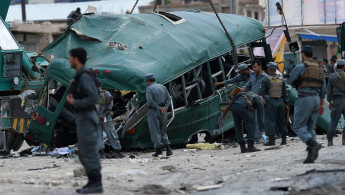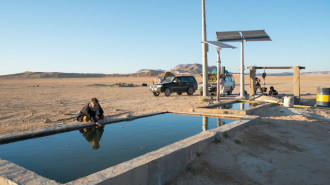Women, children killed in attack on Afghan passenger bus
At least 8 people were killed when a roadside bomb hit a bus in restive western Afghanistan on Tuesday, officials said.
Around 40 others, mostly women and children, were targeted in the attack on the passenger bus.
"It was a bomb planted by the Taliban to hit security forces but... it got a passenger bus," Farah provincial police spokesman Muhibullah Muhib told AFP.
There was no immediate confirmation from the Taliban that they were responsible.
The bus began its journey in the western city of Herat and was headed for the Afghan capital.
The explosion happened as it travelled through Farah's Bala Baluk district at 4:30 am, provincial governor's spokesman Naser Mehri told AFP.
Around a dozen of the wounded - mostly members of the Hazara ethnic group who tend to follow Shia Islam in the Sunni-dominated country - were taken to hospital in Herat.
Among them was Mohammad Zahir, 40, who had been travelling with his newly married daughter to visit relatives in Kabul.
"The bus was driving on the main road when I heard a big bang," Zahir told AFP.
"When I woke up I found myself in the hospital. I still don't know what's happened to my daughter."
Afghan President Ashraf Ghani condemned the attack.
"Harming civilians, especially scholars, children and women, is against the Ulema Council's (Afghanistan's top religious leaders) fatwa," Ghani said in a statement, referring to the group's proclamation in June that suicide attacks and explosions were "haram" or prohibited in Islam.
Civilian deaths
Afghanistan's largest militant group is very active in the region and often uses improvised explosive devices against government officials and Afghan and foreign forces.
Civilians have borne the brunt of the 17-year conflict and improvised explosive devices, such as remotely detonated or pressure-plate bombs, are one of the main cause of casualties.
Such IEDs caused 877 civilian casualties in the first half of 2018 - 232 deaths and 645 wounded - accounting for 17 percent of overall civilian casualties, the latest UN figures show.
A total of 1,692 civilians were killed in the conflict during the first six months of this year. Another 3,430 were wounded.
That was the highest number of civilian fatalities for the period since the United Nations Assistance Mission in Afghanistan began keeping records in 2009.
Militant attacks and suicide bombs were the leading causes of death.
The Taliban has a strong presence across western Afghanistan, particularly in Farah. It launched a major attempt to take over the provincial capital in May, triggering intense fighting with US and Afghan forces.
After a day-long battle the Taliban fighters were forced to the outskirts of the city.
Agencies contributed to this report.





 Follow the Middle East's top stories in English at The New Arab on Google News
Follow the Middle East's top stories in English at The New Arab on Google News


